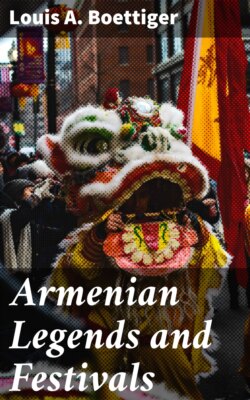Читать книгу Armenian Legends and Festivals - Louis A. Boettiger - Страница 3
На сайте Литреса книга снята с продажи.
Introduction
ОглавлениеTable of Contents
The study which follows has a very definite objective apart from the mere gathering of materials, namely, to interpret as far as the subject-matter would permit, the social life of the Armenian people. The legends and festivals described have thus been selected from a larger mass of material with this principle in mind. I have, therefore, omitted such as seemed to me to be of little or no social value. Also, in full accordance with this plan, I have chosen to include certain church ceremonies which give rise to such festivals, and are of such social importance that I considered them an organic part of my subject. Otherwise I think I have kept within the strict confines as indicated by the title of this study.
It must, therefore, be evident that neither Part One on legends, nor Part Two on festivals, is exhaustive, and this is necessarily so, not only because of my selective plan, but also because much of the work on this and kindred subjects has been done by the French, and is available only on the continent. All of the sources used are, however, original in two possible constructions of the term; that is, they are the works of Armenians who have lived for many years in their native land, or of foreigners, generally French or English, who have traveled through the country and gathered their material first hand. A large portion of this matter I have been able to check up and add to through my wife, an Armenian, who lived in Constantinople most of her life, and who is naturally versed in the folk-lore of her native land. While this has been the chief source of my interest, it is not the only one, for during my three years’ work in Beirut, Syria, I became acquainted with many Armenians.
To describe a legend, or a festival, and to tag it Armenian, is about as purposeful and enlightening as to explain Plato’s idea of social unity to a person who has no picture of Greek civilization. I have, therefore, found it necessary to fit these legends and festivals into the particular settings that seemed to me most natural. The legends that date from pagan times are meaningless apart from their historical background; the church legends and festivals are without value apart from their religious-historical setting, while such legends as those of Ararat require a description of the natural environment to which they belong. The conclusions and interpretation which this study gives rise to, as well as the manner in which I have organized and attempted to weave the material together into a unified fabric, are my own.
Most of the books used have been supplied by the Case Memorial Library of Hartford Theological Seminary, and I owe the Reverend M. H. Ananikian of that institution my thanks for his gracious coöperation in suggesting materials and providing me with them. I am also deeply indebted to Professor J. W. Beach for his painstaking criticism and valuable suggestions, and for the corrections and suggestions offered by Professor W. S. Davis and Professor A. E. Jenks. To Professor A. J. Todd I am especially grateful, for it was under his direction and supervision that this study was carried out.
Louis A. Boettiger
